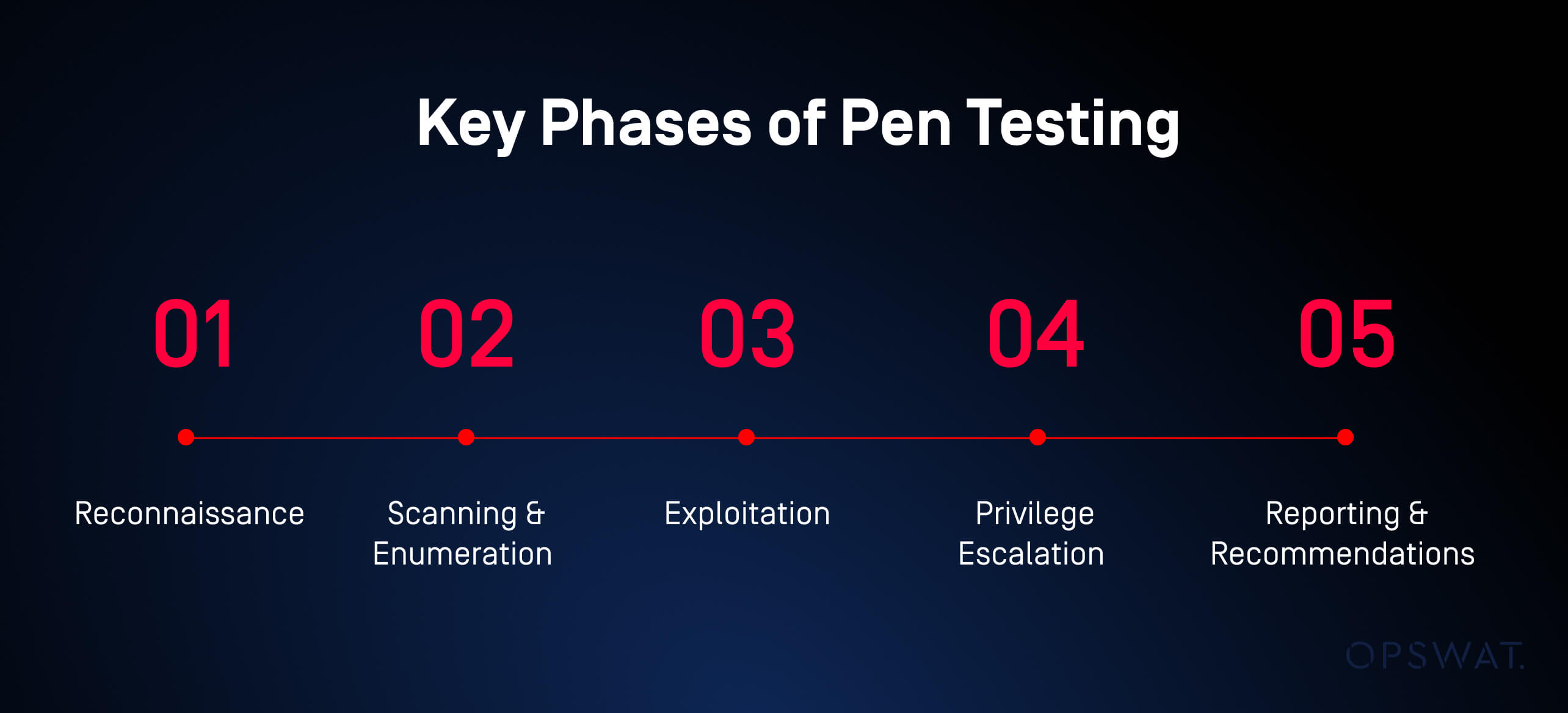What is Penetration Testing?
Penetration testing, commonly known as pen testing or ethical hacking, is a proactive security measure that involves simulating real-world cyberattacks on your systems and networks. Unlike malicious hackers, penetration testers work within authorized boundaries to identify security weaknesses before they can be exploited by actual threat actors.
This critical security assessment serves as a cornerstone of any comprehensive cybersecurity strategy. By conducting controlled simulated attacks, organizations can evaluate their security posture and validate the effectiveness of their existing security controls. The process helps discover vulnerabilities that might otherwise remain hidden until a genuine security breach occurs.
Penetration testing fits within the broader context of security assessments and audits, working alongside other security best practices to create a robust defense against cyber threats. It provides organizations with actionable insights into their threat detection strategies and helps identify potential security gaps in critical infrastructure.
Penetration Testing vs. Vulnerability Assessment
While both are critical security practices, penetration testing and vulnerability assessments serve different purposes:
- Vulnerability assessments scan for known vulnerabilities and provide a prioritized list of issues.
- Penetration testing actively exploits vulnerabilities to assess the impact of a breach and the effectiveness of current defenses.
Organizations typically use vulnerability assessments for regular security monitoring and penetration testing for deeper validation of their security hardening efforts.
Why Is Penetration Testing Important?
Penetration testing uncovers vulnerabilities before attackers can exploit them. It validates the effectiveness of security controls through simulated cyberattacks and supports regulatory compliance while reducing the risk of data breaches. This proactive approach helps organizations maintain trust with customers and partners.
Modern cyberthreats are becoming increasingly sophisticated, making it essential for organizations to adopt proactive security measures. Penetration testing helps discover vulnerabilities across your entire attack surface, from web applications to network infrastructure.
Key Benefits of Pen Testing
Early discovery of vulnerabilities represents one of the most significant advantages of regular penetration testing. By identifying security gaps before they're exploited, organizations can implement vulnerability remediation strategies that prevent costly security breaches.
Improved security posture is another crucial benefit that extends beyond technical improvements. When organizations regularly conduct penetration testing, they develop a deeper understanding of their security posture and can make more informed decisions about security investments and priorities.
Enhanced incident response preparedness ensures that when security incidents do occur, teams are better equipped to respond quickly and effectively. Penetration testing reveals potential attack paths and helps security teams understand how threats might propagate through their systems, leading to more comprehensive response plans.
How Penetration Testing Works: Approaches and Methodologies
Penetration testing follows structured methodologies that ensure comprehensive coverage of potential attack vectors. The following three primary approaches each offer different perspectives on your security posture and provide unique insights into potential vulnerabilities:
- Black box: No prior knowledge of the system.
- White box: Full access to source code and documentation.
- Gray box: Partial knowledge, simulating an insider threat.

Each phase builds upon the previous one, creating a comprehensive security gap analysis that reveals both individual vulnerabilities and potential attack chains.
Simulated Attacks and Security Controls Testing
Simulated attacks form the core of effective penetration testing, providing realistic scenarios that test your security controls under conditions that mirror actual threats. These controlled attacks help validate whether your security measures can withstand real-world assault techniques.
Security controls testing goes beyond simple vulnerability scanning to evaluate the effectiveness of your defensive measures. This process examines how well your security infrastructure responds to various attack scenarios, including attempts to bypass authentication, escalate privileges, and move laterally through your network. Learn more about Application Security Best Practices.
Regulatory Compliance and Risk Management
Penetration testing plays a critical role in demonstrating compliance with data protection and cybersecurity standards such as:
- PCI DSS (Payment Card Industry Data Security Standard)
- ISO/IEC 27001
- NIST guidelines
Risk assessment and mitigation represent core functions of penetration testing within broader risk management frameworks. By identifying vulnerabilities and demonstrating their potential impact, penetration testing provides the data necessary for informed risk management decisions. The contribution to data breach prevention cannot be overstated. Organizations that regularly conduct penetration testing significantly reduce their risk of experiencing costly security incidents.
Meeting Compliance Requirements
Penetration testing serves as a requirement for various compliance standards, including PCI DSS, HIPAA, and SOX. Each standard has specific requirements for testing frequency, scope, and methodology, making it essential for organizations to understand their compliance obligations.
Demonstrating due diligence to regulators and stakeholders requires more than simply conducting tests. Organizations must maintain proper documentation, implement recommended remediation measures, and show continuous improvement in their security posture.
Who Performs Penetration Testing?
Organizations have several options for conducting penetration testing, each with distinct advantages and considerations. Internal security teams bring deep knowledge of organizational systems and processes, while third-party providers offer specialized expertise and objective perspectives.
Regardless of their origin, highly skilled penetration testers combine knowledge, experience, and recognized certifications. These credentials prove their proficiency in ethical hacking, vulnerability assessment, and reporting.
Choosing a Pen Testing Provider
When evaluating potential pen test partners, consider the following:
- Experience & Expertise: Look for a provider with a proven track record in your industry and with technologies similar to yours (e.g., web applications, networks, cloud, IoT, OT). Their team should demonstrate a deep knowledge of current threats and attack methodologies.
- Methodology & Approach: A reputable provider follows established, transparent methodologies (like PTES or OWASP Testing Guide) and combines automated tools with extensive manual testing. Avoid firms that rely solely on automated scans, as these often miss complex vulnerabilities and business logic flaws.
- Reporting & Remediation Support: The final report should be clear, concise, and actionable, detailing findings, risk levels, and practical remediation steps. Look for providers that offer post-test support, including retesting to verify fixes.
- References & Reputation: Ask for client references and check online reviews or industry accreditations (e.g., CREST, if applicable in your region). A strong reputation indicates consistent quality and ethical conduct.
- Communication & Professionalism: The provider should communicate effectively throughout the engagement, from scoping to reporting, and maintain strict confidentiality regarding your sensitive data.
The provider's methodology and reporting practices are equally important considerations. Look for providers who follow established frameworks such as OWASP Testing Guide or NIST guidelines and who provide comprehensive reports with clear remediation recommendations.
Pros and Cons of Penetration Testing
Understanding both the advantages and limitations of penetration testing helps organizations make informed decisions about their security testing programs and set appropriate expectations for results.
| Advantages | Limitations |
|---|---|
| Proactive Risk Mitigation | Cost and Time |
| Validates Security Controls | Limited Scope |
| Supports Compliance | Possible Disruption to normal operations |
Pen Testing as Part of a Holistic Security Strategy
Given its unique benefits and inherent limitations, penetration testing should not be viewed as a standalone solution but rather as a vital component of a broader, holistic cybersecurity strategy. To maximize value, integrate penetration testing with:
- Regular vulnerability assessments
- Security awareness training
- Incident response planning
Organizations can use the OWASP Top Ten Web Application Security Risks and the 10 Best Practices for File Upload Protection by OPSWAT to assess their security posture and implement the most appropriate layers of defense within their web application environment.
Penetration Testing for Cybersecurity Careers
Whether you're a security analyst, network administrator, or security manager, knowledge of penetration testing principles and practices enhances your ability to protect organizational assets. Many organizations value professionals who understand both offensive and defensive security practices, making penetration testing experience valuable for career advancement.
Skills and Certifications for Penetration Testers
To succeed in the field, professionals should develop:
- Networking Fundamentals: A solid grasp of TCP/IP, network protocols, routing, and common network services (DNS, HTTP, etc.) is foundational.
- Programming/Scripting: Proficiency in at least one scripting language (e.g., Python, PowerShell, Ruby, Bash) for automating tasks, exploiting vulnerabilities, and developing custom tools.
- Vulnerability Assessment: The ability to identify, analyze, and understand the impact of security weaknesses in systems and applications.
For aspiring and current penetration testers, certifications validate expertise and demonstrate a commitment to the profession. Some of the most recognized and valued include:
- OSCP (Offensive Security Certified Professional): Respected, hands-on certification for offensive penetration testing skills.
- CEH (Certified Ethical Hacker): Covers a broad range of ethical hacking concepts and tools.
- CompTIA PenTest+: Focuses on the latest penetration testing, vulnerability assessment, and management skills.
- eWPT (eLearnSecurity Web Application Penetration Tester): Specializes in web application security testing.
- GPEN (GIAC Penetration Tester): Comprehensive certification covering various methodologies.
OPSWAT’s Pen Testing Team: Unit 515
Unit 515 is OPSWAT’s elite red team initiative, specializing in proactive cybersecurity through adversarial simulation, advanced testing, and in-depth discovery. Our team combines deep technical expertise with practical business understanding to develop a comprehensive testing program that meets your specific needs and regulatory requirements.
Ready to strengthen your security posture? Contact Unit 515 today to learn how our penetration testing services can help identify vulnerabilities in your systems and improve your overall cybersecurity strategy.
Frequently Asked Questions (FAQs)
What is a penetration test (pen test)?
A penetration test is a simulated cyberattack conducted to identify vulnerabilities in systems, networks, or applications before real attackers can exploit them.
Why is penetration testing important?
Penetration testing uncovers vulnerabilities before attackers can exploit them. It validates security controls, supports regulatory compliance, reduces data breach risk, and builds stakeholder trust.
What are the pros and cons of pen testing?
Pros include proactive risk reduction, security control validation, and compliance support. Cons include potential cost, limited scope, and temporary disruption.
Why do we need penetration testing?
To stay ahead of cyberthreats, meet compliance obligations, and ensure that defenses are robust and effective.
Who performs pen tests?
Pen tests can be done by internal security professionals or third-party providers with specialized certifications and experience.
What are the 5 key phases of pen testing?
- Reconnaissance
- Scanning & Enumeration
- Exploitation
- Privilege Escalation
- Reporting & Recommendations

